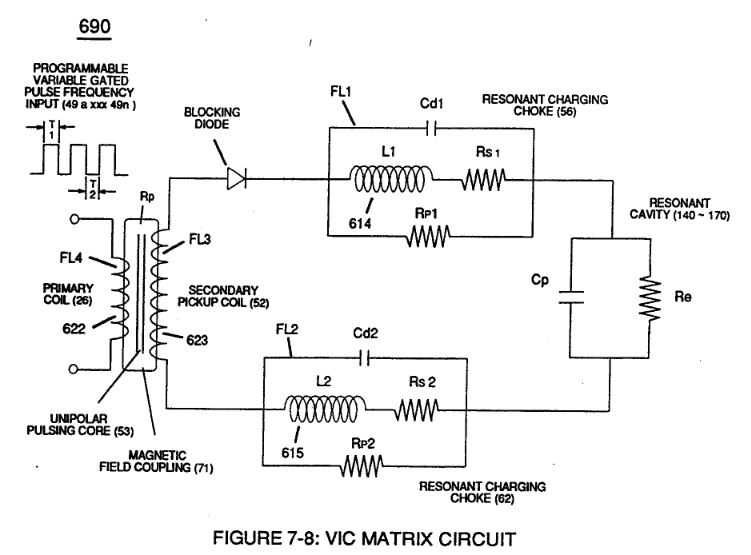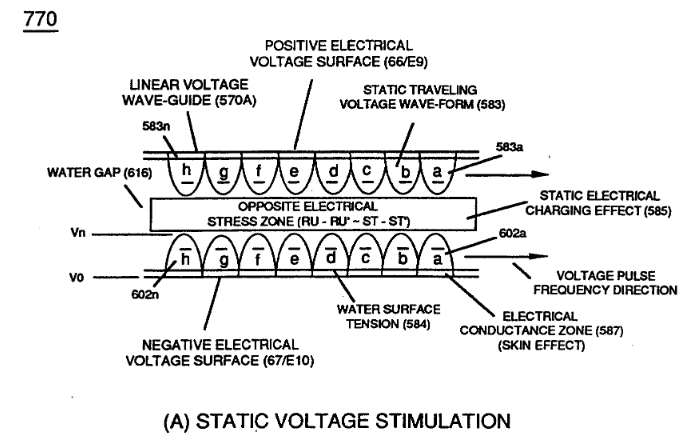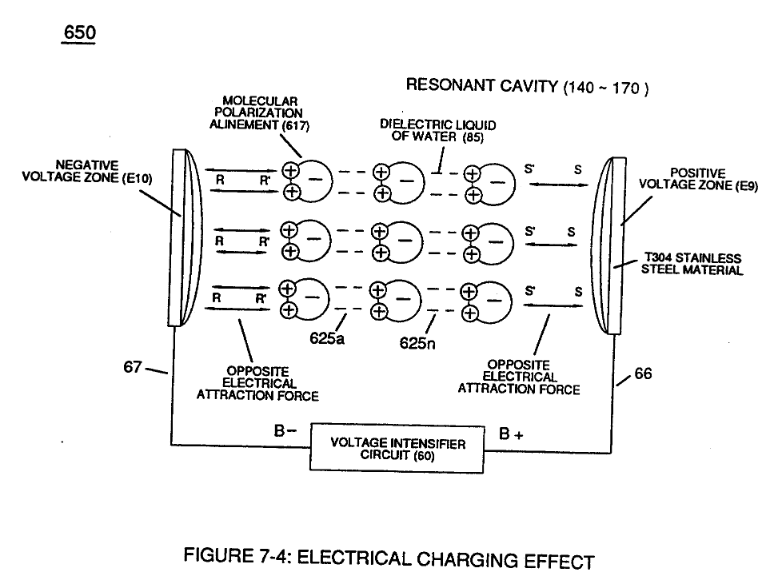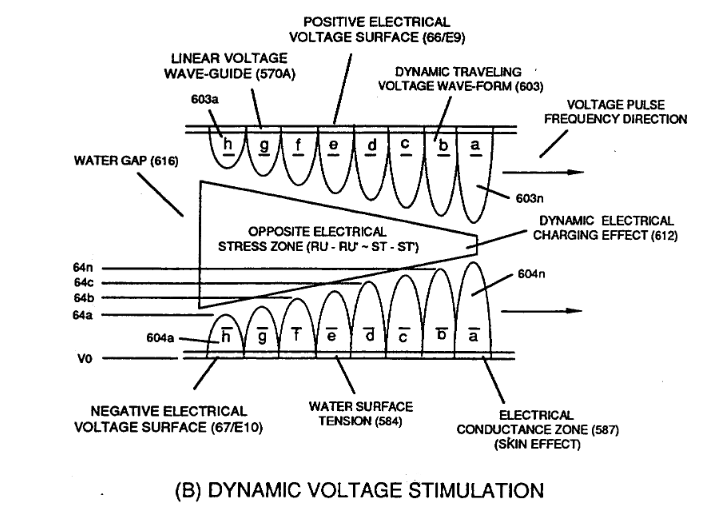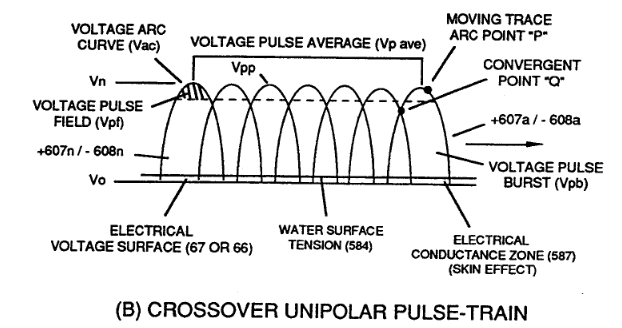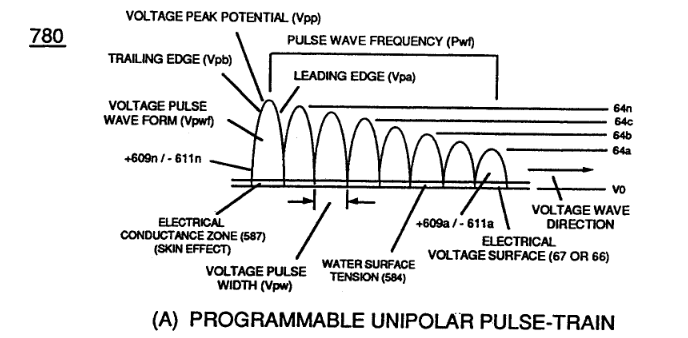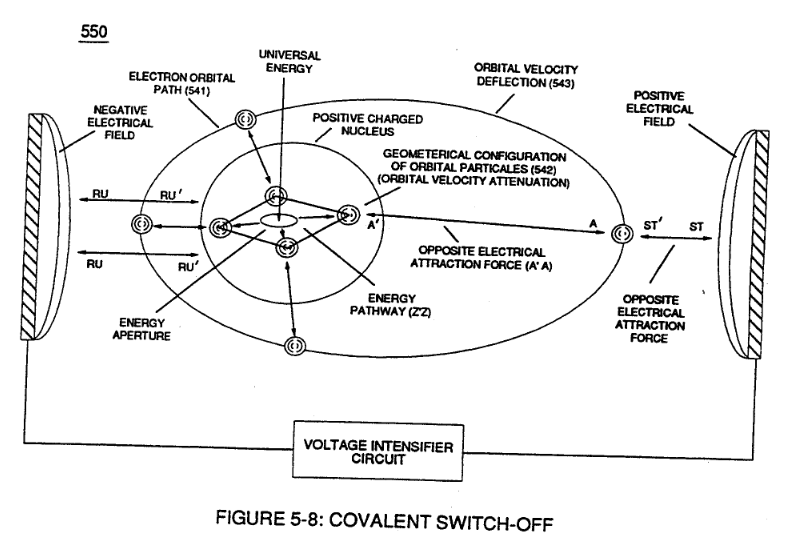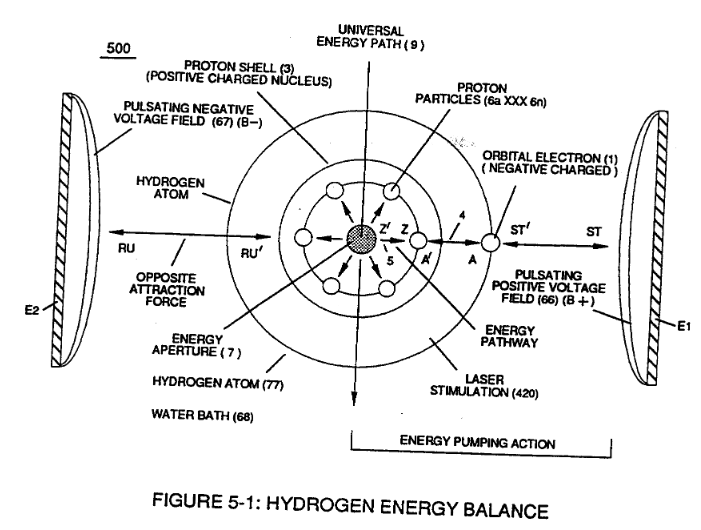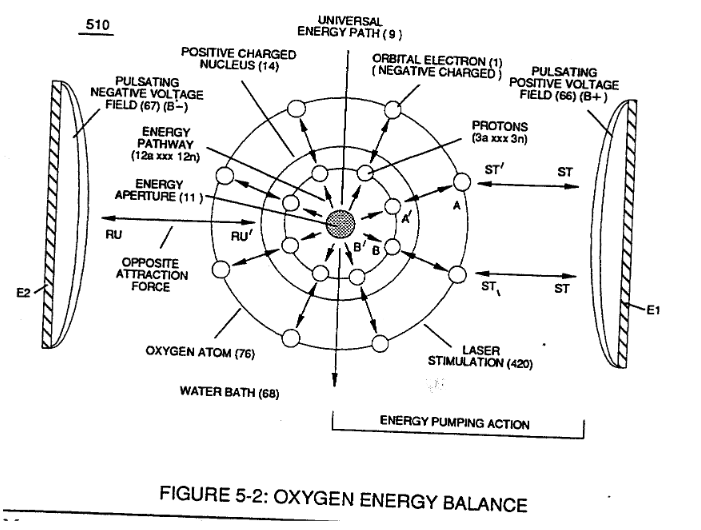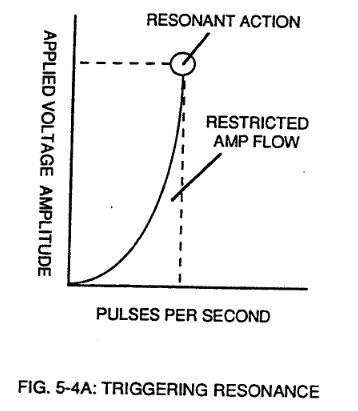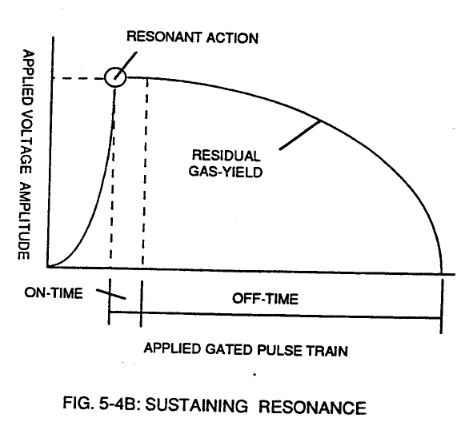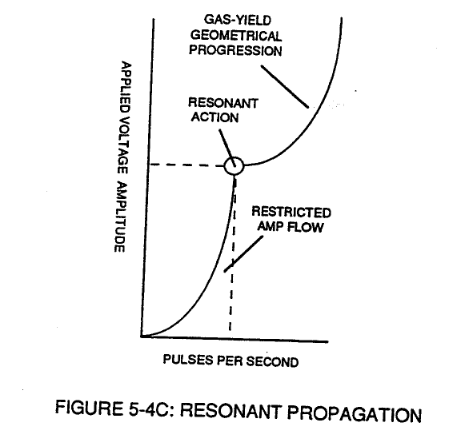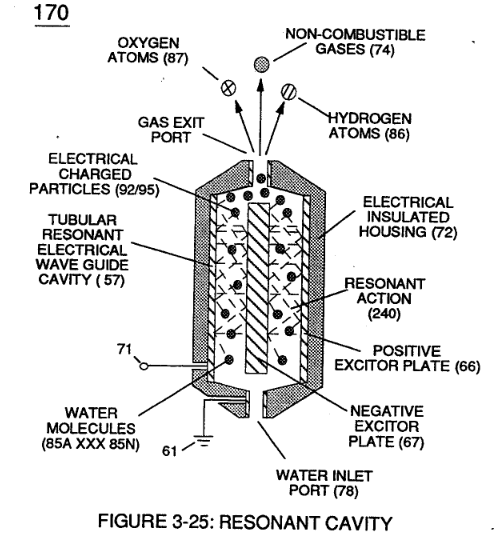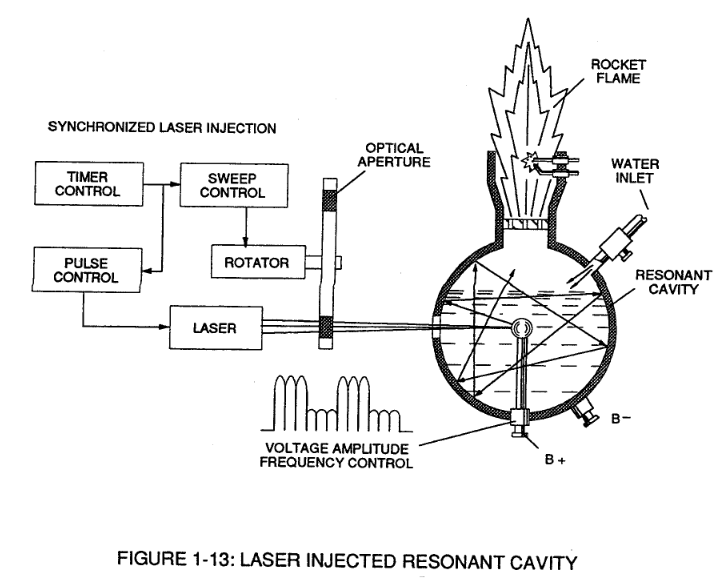8-4 - State Space (Sp)
During the electrical-formation (66- Vpa/Vpb - 67- Vpa/Vpb) of each opposite Electrical Voltage-Wave (66-583 - 67-602), opposite electrical attraction force (RR' - SS') of Figure (7-4) is produced across water cap (Cp) of Figure (7-8) which, now, sets up and defines the conditions of “State Space," as illustrated in (770 A/B) of Figure (8-1) as to (650) of Figure (7-4).
|
(Cp) of Figure (7-8) |
(770 A) of Figure (8-1) |
|
(650) of Figure (7-4) |
(770 B) of Figure (8-1) |
The newly formed Opposite Electrical Attraction Force (RR' - SS') intensity is directly related to the applied Voltage Amplitude Burst-Time (Vpa - Vn -Vpb) as to the Voltage Burst-Frequency (49a xxx 49n) as to Voltage Peak Excursion Point "P" at the height of Unipolar Voltage Pulse Wave (583/602) which, in turns, determines maximum Voltage Peak-Potential (Vpp) at any given time during each Voltage Pulsing Cycle (Vpa/Vpb).
Electrical Attraction Force intensity (RR' - SS' as to RU/RU' - ST/ST' as to 550 of Figure 5-8) at Peak Voltage Potential (Vpp) is either increasing or decreasing or remaining constant as to Voltage Peak Excursion Point "P" trace-position which scans the exact Pulse Wave-Form (66- 583/67-602) being produced, as illustrated in (780B) of Figure (8-2).
|
(780 B) of Figure (8-2) |
Equalizing Voltage Pulse-Scan (Bps) from start of one Voltage Pulse-Field (Vpf) to the start of next Voltage Pulse-Field (Vpfa + Vpfb + Vpfc + Vpfn) is determined by the total average of the number of applied Voltage-Pulses (Vp ave.) making up opposite Voltage Pulse Train (583/602a xxx 583/602n) in synchronous movement.
Generally speaking, Arc Curve (Vac) changing/varying to Arc-Line (Val) of Unipolar Voltage Pulse Wave-form (Vpwf) defines Voltage Pulse Field (Vpf) scan profile (Vsp) by which Trace-point "P" determines the type of "State Space" being used to propagate "Voltage Tickling" of water molecule (85) undergoing "Electrical Stress" under different fluid-pressures.
Whenever, Voltage Excursion Point "P" is always changing in a given space-time, "State Space" is referred to as “Dynamic State Space;" whereas, "Static State Space" exists when Voltage Excursion Point "P" remains constant during a precise period of space-time at Peak Voltage Potential (Vpp) forming clipped Voltage Pulse Wave-form (Vcwf) during Voltage Pulse Shaping by way of Programmable Pulsing Circuit (WFC project 422DA/423DA) electrically interfaced with VIC Matrix Circuit (690), as illustrated in (780) of Figure (8-2).
|
|
(780 A/B/C) of Figure (8-2) |
|
Dynamic State Space causes Opposite Electrical Attraction Force (RR' - SS') to continually vary in electrical intensity (RR'SS' cei) as to formation of Voltage Peak Curve (Vpc); wherein, Static State Space allows Opposite Attraction Force (RR' -SS') to remain at constant electrical intensity (RR' - SS' cei) when Peak Voltage Potential (Vpp) is clipped in forming Arc-Line (Val), as illustrated in (780C) of Figure (8-2).
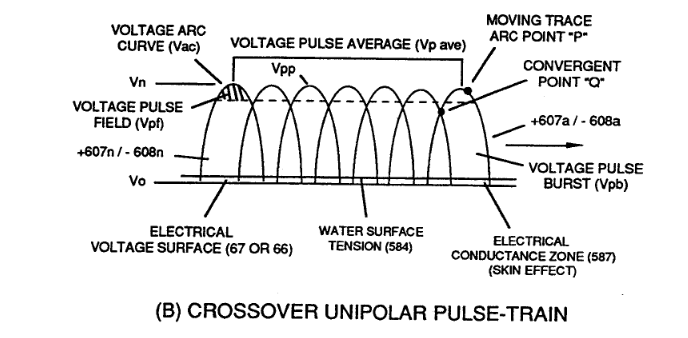 Crossover Unipolar Pulse Train (780B) is used when particle oscilIation of the water molecule atom (s) is/are to be continually electrical stressed (RR' -SS' vei) under changing conditions of higher magnitude (Compressing Voltage Pulse Wave-form) than the use of Planar Unipolar Pulse Train (780A).
Crossover Unipolar Pulse Train (780B) is used when particle oscilIation of the water molecule atom (s) is/are to be continually electrical stressed (RR' -SS' vei) under changing conditions of higher magnitude (Compressing Voltage Pulse Wave-form) than the use of Planar Unipolar Pulse Train (780A).
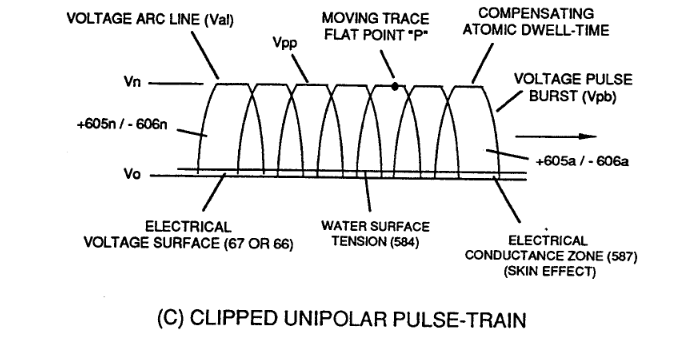 Clipped Unipolar Pulse Train (780C) is used to encourage further increase in atomic dwell-time capable of raising Atomic Energy Level (AEI) of the Water Atoms to even a higher energy-state before Snapping-Action occurs when Unipolar Pulse Wave (Upw) returns to ground state (Vo) after voltage propagation (Vpa/Vpb).
Clipped Unipolar Pulse Train (780C) is used to encourage further increase in atomic dwell-time capable of raising Atomic Energy Level (AEI) of the Water Atoms to even a higher energy-state before Snapping-Action occurs when Unipolar Pulse Wave (Upw) returns to ground state (Vo) after voltage propagation (Vpa/Vpb).
Of course, the repetition-rate of "Atomic Snapping Action" (Asa) (the number of Voltage Pulse Fields Vpf occurring per unit of space-time) directly determines the resultant energy level of Static Electrical Charging Effect (585) of Figure (8-1) since “Particle Oscillation" is being used as a “Energy Generator" (EGpo), as so subscribed in memo (424) titled Atomic Energy Balance of Water as to the functional parameters associated with Dynamic Voltage Potential Wave-form (600) of Figure (6-3) which uses Voltage Pulse Potential of opposite electrical polarity of attraction (RR' - SS' as to RU/RU' – ST/DST') to perform work in the following sequence of events in an instant of time: Electrical Polarization Process (160) (elongating the water molecule
... changing the time share rate of the covalent electrons
... switching off the covalent bond by attenuating the electromagnetic fields of the electrical stressed atoms undergoing molecule separation;
Universal Energy Priming Stage (500) (particle oscillation as a energy generator by deflecting atomic particles under changing electrical stress);
Liquid to Gas Ionization Stage (230) (ejecting electrons from the atomic structure under divergent electrical stress); and
Thermal Gas Triggering Stage (E9d) (gas igniting the electrically stress combustible gas atoms farthest from the state of electrical equilibrium)
... triggering Hydrogen Fracturing Process (90) (subcritical-state combustible gases being spark-ignited under Electrical Resonance of Stress).
In terms of Particle Oscillation (Poe) as a Energy-Generator (EGpo), if Voltage Arc Line (Val) length is extended while Voltage Amplitude (xx 64a - 64b - 64c - Vn) is adjusted to higher Voltage Peak-Potential (Vpp) then greater atomic interaction (585) of Figure (8-1) (see WFC memo 424 titled Atomic Energy Balance of Water, once again) occurs when particle oscillation (Poe) of deflection of atomic mass (see 550 of Figure 5-8) (atom elongation) is electrically stressed farthest from the point of state of atomic-equilibrium by way of opposite Voltage Electrical Attraction Force (RR' - SS' as to RU/RU' - ST/ST'), as further illustrated in (500) of Figure (5-1) as to (510) of Figure (5-2).
|
(585) of Figure (8-1) |
(550 of Figure 5-8) |
|
(500) of Figure (5-1) |
(510) of Figure (5-2) |
Voltage Tickling of State Space under "Resonant Electrical Stress" without amp influxing while ''Tuning-In' to the dielectric properties of water is herein referred to in this WFC Tech-manual as "Resonant Action," as illustrated graphically in Figure (5-4 A,B,C) as to Resonant Cavity (170) of Figure (3-25) as to Figure (1-13).
|
5-4 A |
5-4 B |
5-4 C |
|
(170) of Figure (3-25) |
|
Figure (1-13) |

